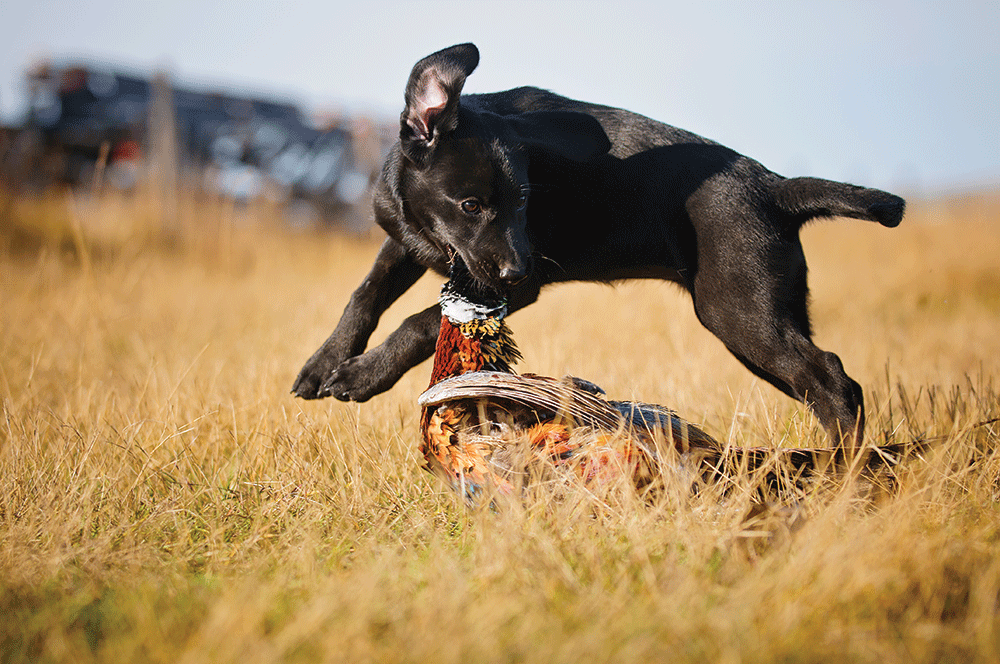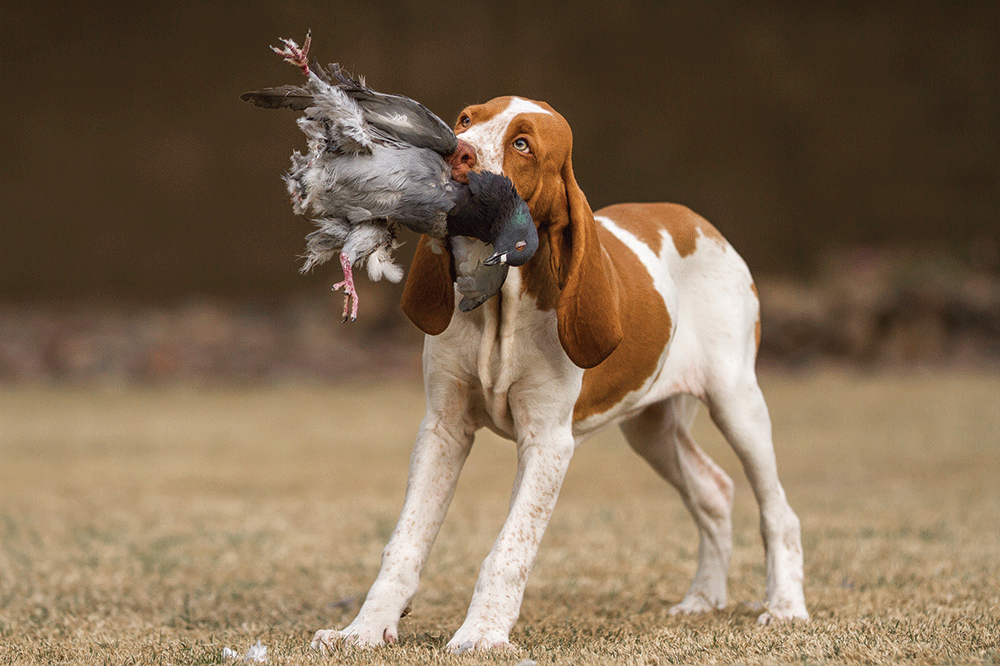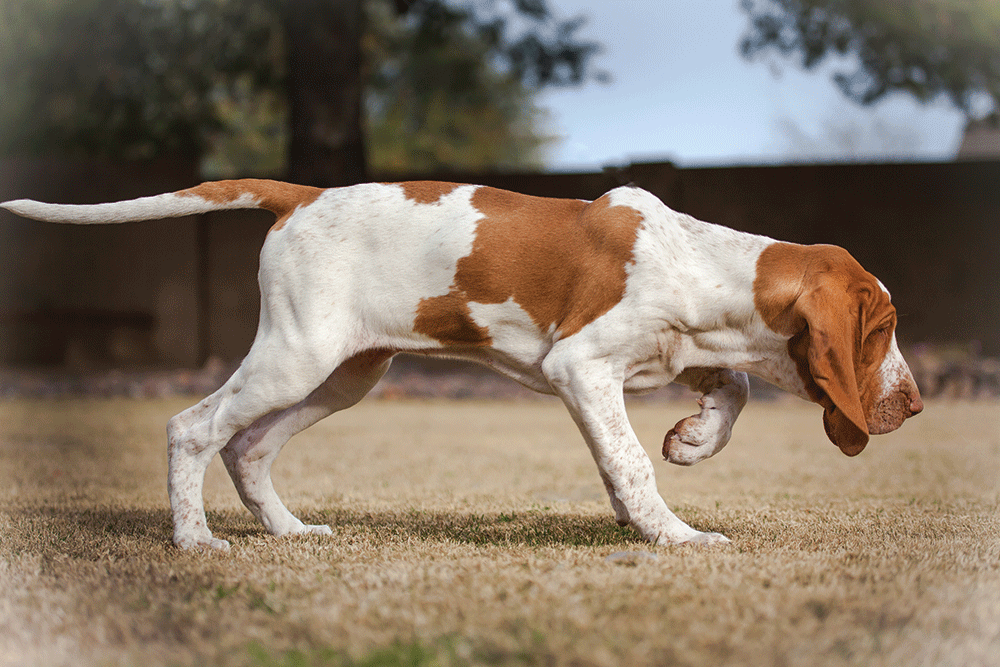PUPPY PRIMER

Only 9 weeks old, Gauge had feet three times larger than his nose and ears that flapped wildly, taking on a life of their own. His owner sat on Gauge’s dog bed, next to a basket of Beanie Babies. She tossed a Beanie, which rattled as it hit the floor. Gauge lunged and pounced on it like the planet’s most dedicated varmint hunter. The problem was, he hadn’t yet developed the coordination needed to handle the smooth floor tiles, so Gauge’s attack usually ended in a pile of discombobulated puppy sliding into a kitchen cabinet with the toy lodged under his belly.
He flipped the limp toy in the air. He carried a lumpy ducky halfway back to his owner. He dove on a fuzzy pink crab and then ran into his owner’s lap with a toy alligator. The warm dog bed was where he liked to be. There he’d be rewarded either with a treat or another toy toss. Gauge obviously enjoyed the game. . . and had no idea that he had started retriever training.

Technically, “training” isn’t the correct word to use here. “Pretraining” is more accurate. From the moment we bring home our bird dogs, everything we do with those puppies teaches them something that in some way will impact their subsequent training. In this, three components are at work simultaneously: socialization, neural development, and an introduction to hunting-related tasks. Animal behaviorist Ed Bailey says that from the time puppies become mobile to the 12-week mark is when they learn—from their dam, littermates, and the people with whom they bond—all social amenities and signals.
“Everything after that is practice, honing the social skills of a well-based pup, all set to take on training,” Bailey says. Confidence in themselves, confidence in their owners, and the ability to understand people’s and dogs’ body language will help them respond to the challenges of gun-dog training.
Research has shown that, as with children, young dogs’ brains develop their synaptic connections in response to external stimuli. Simply put, more experience and input leads to more developed neural pathways in the brain. Vary the environment, vary the games, vary the sights and sounds at an early age, and a dog will be, if not actually “smarter,” better able to handle new information—complex tasks and situations—later on.

As far as preparing the foundation for hunting, pro trainer Tom Dokken says, “Remember that every time you are with your puppy, you are training.” One example Dokken gives is taking something from a puppy’s mouth, which sends the message that we don’t want them to have things in their mouths. “This is the exact opposite of what you will want later on,” he explains. “So think hard about how you approach the puppy when he’s got something and you need to get it away from him. Perhaps when you take a shoe away, replace it with a nylon bone or toy, something you intend for him to chew on.”
Puppies are amazing. In the first 4 to 6 months, they learn remarkably fast. Food and warmth are their motivators, which we can use to our advantage by being the providers of both. Jet’s leash training is a perfect example of the warmth motivator, in this case home being the source of warmth and security. An 8-week-old black Lab, she trundled around with confidence. When the lead was attached for the first time, however, she balked. Walking away from the house, she wailed sounds more painful to hear than an amp screeching guitar feedback. Jet scrunched up her face, leaned back, and dug her toenails into the gravel driveway.
As soon as her owner turned around, however, Jet pranced with him like a show-ring veteran—heading back toward the zone of warmth did the trick. On their second attempt, she fought less. On the third walk, Jet’s understanding that she’d be returning home (as opposed to being abandoned in the scary, wild unknown) helped her accept the leash.

Pro trainer Blaine Carter points out that even basic play with your pup is a learning experience. “Young dogs need to learn ‘bite inhibition.’ This happens while you play with puppies. If they get too rough with their mouths, you speak with a negative voice, saying ‘bad’ or cry ‘ouch.’ The pup will learn to play with less bite pressure. It’s interesting to watch this behavior in the whelping box with mom or siblings. Also, it teaches the young dogs that there are limits to the levels of play. Remember, this is not an obedience skill but a learned behavior.”
How does that lesson pay off later? Many of us use corrections like the rear “armpit” flick in heeling or steadiness training. The dog might jump around in surprise and snap the air, but will have no thought of actually biting. Furthermore, when we head into the grouse woods or quail fields, chances are we’ll be with other hunters and their dogs, or at least will be likely to encounter others. No one wants a dog fight by the truck or near the game bag. Since dogs relate to their world a great deal through their mouths, learning to control their bite is critical.
Pretraining comes in all forms of games and interactions. Pausing by the top or bottom of a staircase is a perfect time to say “whoa.” We don’t have to physically restrain the puppy; but the pup, paused at a natural, visible threshold, will look to us for the signal to go. Say the word and then climb or descend. Similarly, it’s easy to say “whoa” or “stay” and then wait for the puppy to be still before putting down a food bowl.

Using place boards is another easy pretraining method that can lead to a game. If we drop a few treats or a handful of puppy food on a board, our puppy will naturally run to it. Then we run to the next place board and do the same. The puppy will follow. And then on to the next board. Soon he or she is convinced that the place board is a great place to go, and will wait there for the treats. Thus the stage is set to start using the “stay” command. Sometimes the reward can be happy praise or a favorite scratch behind the ear—rewards can vary. Place-board work builds the foundation for sit and stay, recalls, and eye contact as our puppies look to us for the signals that will produce the rewards.
But what if the pup doesn’t do what we’re expecting or looking for? It’s best to just ignore the behavior we want nipped in the bud. Spending time on correcting a puppy takes away from the pup learning, particularly because many of us don’t have good timing—the ability to make the right correction in time for it to have an effect. A trainer we know once said, “The time it takes to drop your car keys to the floor is the amount of time it takes to ‘tag’ the behavior you want.” That is quick.
Another great example of how pretraining can lead to quicker success down the road is in starting the “hold” at a very early age. Since German shorthair Tiza was expected to retrieve both on land and in the water, part of her schooling included a “trained retrieve,” in which through some type of pressure she would learn to pick up, carry, and deliver an object whenever asked to do so. The trained retrieve can be a struggle; many dogs resist having something put in their mouths. To avoid that, when Tiza was small, her owner handled her mouth frequently, getting her adjusted to the contact.
Once Tiza’s adult canine teeth came in, her owner began placing her gloved hand, palm up, inside Tiza’s mouth, resting it lightly behind the canines, rewarding her acceptance with treats or praise. If she resisted, she could easily be held with a firm hand around her chest or through her collar. After a few sessions, the gloved hand was replaced by a bumper. When the drill moved to the training table, Tiza was eager to pick up the bumper or bird, and the final steps of the trained retrieve went smoothly…all before she was 6 months old. Had Tiza’s owner waited until she was fully grown to start this retrieving program, some big-time wrestling might have resulted.

From the 7th or 8th week, the next two months are when our puppies should be exposed to just about everything they will encounter for the rest of their lives—cars, children, gunshots, live birds, dead birds, and the like.
Taking them into the wild is essential. In open fields or dense cover, having them explore their future world is a win-win-win scenario for the socialization, brain development, and hunting task triad. The socialization factor comes in the puppy’s relationship to you. As he ranges confidently farther out, he naturally checks back and is reassured that you are there, thus building cooperation as a team. Smells, sights, sounds, and textures offer tremendous sensory input. And this introduction to the terrain in which we’ll be hunting provides the groundwork—pun intended—for the future search for game.
Puppies need to see, touch, hear, and smell everything, with their safety paramount, of course. Indoor games become outdoor games. Beanie Babies lead to bumpers and eventually birds. As our puppies mature, they’ll show us what they’re ready for as we give them the best possible start toward becoming our most treasured hunting partners.
























